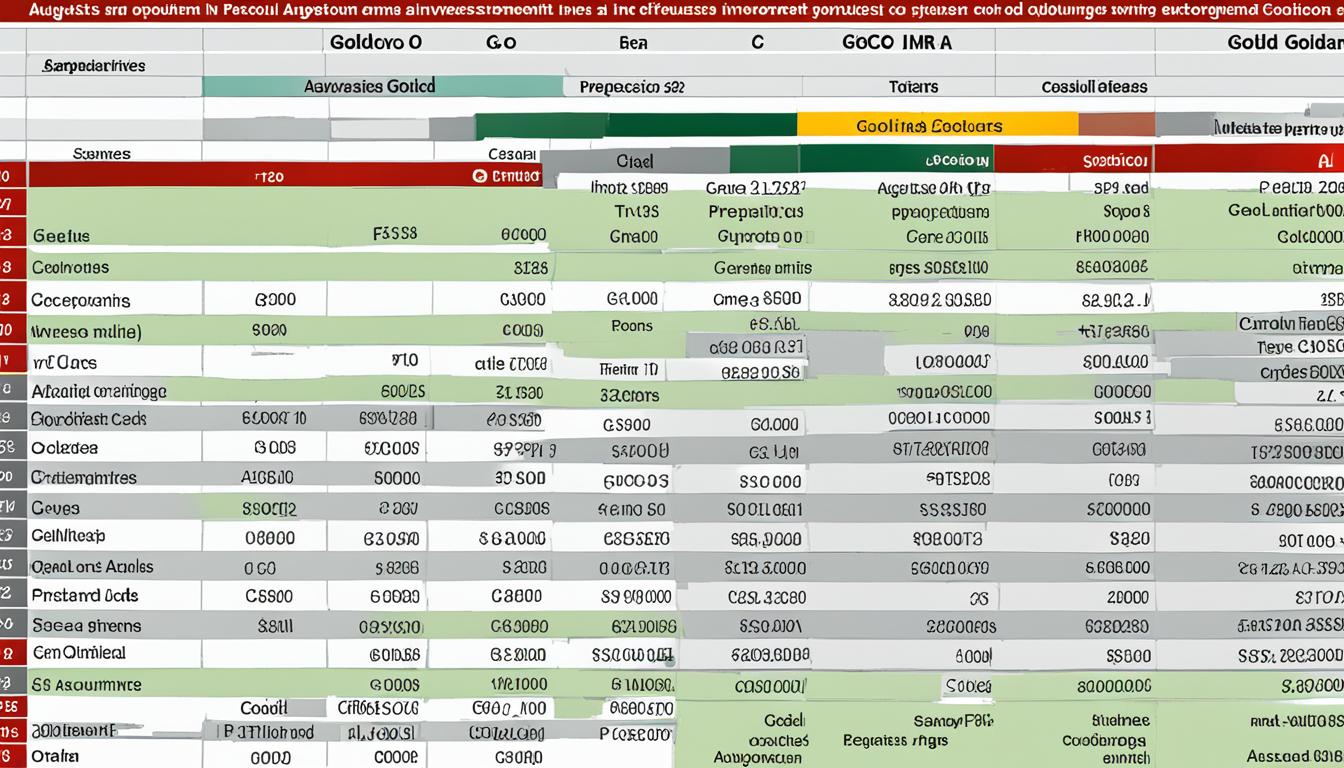When planning for retirement, it is important to consider the top 10 retirement plans. Traditional 401(k) and Roth 401(k) plans come with tax advantages and employer matches. Solo 401(k) plans offer flexibility for those who are self-employed. 403(b) and 457(b) plans are geared towards specific sectors and provide diverse investment options. SIMPLE and SEP IRA plans are tailored for small businesses, offering tax benefits and contribution limits. Federal retirement plans like the Thrift Savings Plan ensure growth opportunities and matching contributions. These choices help secure a financially stable future.
Key Takeaways
- Traditional 401(k) Plans with tax-deferred growth and employer match.
- Roth 401(k) Plans offering tax-free contributions and withdrawals.
- Solo 401(k) Plans for self-employed with higher contribution limits.
- 403(b) Plans tailored for specific sectors with investment options.
- Federal Retirement Plans like Thrift Savings Plan with government matching.
Traditional 401(k) Plans
Discussing the benefits of participating in traditional 401(k) plans can help individuals understand the advantages of saving for retirement through these employer-sponsored accounts.
With traditional 401(k) plans, contributions are made with pre-tax dollars, lowering the current tax burden and enabling tax-deferred growth. Additionally, employers often sweeten the deal by offering an employer match, which is basically free money added to your retirement savings. This match can greatly boost your savings over time, making it a powerful tool for building wealth for the future.
Another perk of traditional 401(k) plans is the ability to take out loans or make hardship withdrawals in certain situations, providing a safety net in times of need. While there are minimum distribution requirements starting at age 72, the flexibility and tax advantages make traditional 401(k) plans an appealing option for individuals looking to secure their financial future.
Roth 401(k) Plans

Roth 401(k) plans offer tax-free contributions, which can be advantageous for retirement savings.
Employer matching options can further boost your retirement nest egg when contributing to a Roth 401(k).
Additionally, the investment flexibility in Roth 401(k) plans allows you to tailor your portfolio to align with your long-term financial goals.
Tax-Free Contributions
Maximizing the benefits of tax-free contributions in retirement planning is a prudent financial strategy that can greatly enhance long-term savings potential. When considering Roth 401(k) plans, keep in mind the advantages they offer:
- Tax-free withdrawals provide financial freedom in retirement.
- Contributions grow tax-free, maximizing your retirement nest egg.
- Accessible to all income levels, Roth 401(k) plans offer a powerful tool for building wealth over time.
Employer Matching Options
When considering employer matching options in Roth 401(k) Plans, it's important to understand the potential impact on your retirement savings. Employers offering matching contributions to Roth 401(k) plans can greatly boost your retirement nest egg. These contributions can help you reach your retirement goals faster by increasing the overall amount saved.
However, it's vital to be aware of the annual limits set by the IRS for contributions to Roth 401(k) plans. By maximizing your contributions while taking advantage of employer matching options within these limits, you can optimize your retirement savings potential. Making strategic decisions regarding employer matching options in Roth 401(k) plans can have a significant impact on your financial future.
Investment Flexibility
In exploring the investment flexibility within Roth 401(k) plans, we can leverage the tax diversification benefits they offer alongside employer matching options for enhanced retirement savings growth.
Roth 401(k) plans provide an excellent opportunity for individuals to secure their financial future with tax-free withdrawals.
The investment flexibility in Roth 401(k) plans allows for a diverse portfolio tailored to individual risk tolerance and retirement goals. This flexibility empowers investors to make strategic decisions that maximize returns and build a robust retirement fund.
With tax-free growth on investments and distributions, Roth 401(k) plans offer a powerful tool for long-term wealth accumulation and financial security.
Solo 401(k) Plans

Considering the benefits of solo 401(k) plans, self-employed individuals can maximize their retirement savings potential with higher contribution limits and flexibility in contributions. Solo 401(k) plans are tailored for those who work for themselves without employees other than a spouse, offering a robust platform to build a substantial retirement fund. With the ability to contribute as both employer and employee, individuals can seize the opportunity to save a substantial amount more compared to traditional 401(k) plans. The table below outlines some key features of solo 401(k) plans:
| Feature | Description |
|---|---|
| Higher Contribution Limits | Allows for greater retirement savings potential compared to other plans. |
| Flexibility in Contributions | Permits both employer and employee contributions for enhanced flexibility. |
| Diverse Investment Choices | Offers a wide range of investment options to align with financial goals. |
Solo 401(k) plans empower self-employed individuals to take control of their retirement planning, offering tax benefits and customization options to secure a comfortable future.
403(b) Plans

As we shift our focus to (b) Plans, it's important to understand that they're common types of defined contribution retirement plans, with 401(k) and 403(b) being popular variations. These employer-sponsored retirement plans offer individuals a powerful tool to save for their future financial security. Here are some key points to take into account:
- Tax Benefits: Both 401(k) and 403(b) plans allow for pre-tax contributions, reducing your taxable income and potentially lowering your tax bill.
- Employer Matching: Many 401(k) plans include employer matching contributions, effectively providing free money to boost your retirement savings.
- Investment Options: These plans offer a range of investment options, empowering you to choose where to allocate your retirement funds strategically.
Understanding the nuances of these defined contribution plans can give you the edge in building a robust retirement portfolio. It's essential to grasp the specifics of each plan to make informed decisions and maximize your retirement savings potential.
457(b) Plans

When delving into (b) Plans, individuals can explore a range of retirement savings options tailored to specific employment sectors. 401(k) plans, prevalent among Fortune 500 companies, offer a way to save for retirement through pre-tax contributions.
For those looking for tax diversification, the Roth 401(k) is an attractive option, funded with after-tax dollars and providing tax-free withdrawals during retirement. Solo 401(k) plans cater to self-employed individuals, allowing for higher contribution limits by combining employer and employee contributions.
Public school, nonprofit, or church employees can benefit from 403(b) plans, which offer pre-tax contributions and potentially include employer matching contributions. Both traditional and Roth 401(k) plans come with annual contribution limits regulated by the IRS and require minimum distributions once individuals reach age 73.
Understanding the nuances of these (b) Plans empowers individuals to make informed decisions about their retirement savings strategies.
Individual Retirement Accounts (IRAs)

When contemplating Individual Retirement Accounts (IRAs), it's crucial to evaluate the variances between traditional and Roth options. Comprehend the contribution limits and grasp the tax advantages each offers.
These accounts are designed for individuals seeking a wider range of investment choices beyond workplace retirement plans. By delving into the nuances of IRAs, we can make informed decisions to secure our financial future.
Traditional Vs. Roth
Choosing between Traditional and Roth Individual Retirement Accounts (IRAs) requires careful consideration of the tax implications and withdrawal strategies that align with your future financial goals. Traditional IRAs offer tax-deferred growth until withdrawal, while Roth IRAs provide tax-free withdrawals on after-tax contributions.
To make the best decision, consider the following:
- Tax-deferred growth: Traditional IRAs allow your investments to grow tax-deferred, potentially reducing your current tax bill.
- Tax-free withdrawals: With a Roth IRA, you can enjoy tax-free withdrawals in retirement, providing flexibility and potential tax savings.
- Required minimum distributions: Traditional IRAs have required minimum distributions starting at age 72, which can impact your retirement income strategy.
Contribution Limits
To understand the rules surrounding contribution limits for Individual Retirement Accounts (IRAs), one must be aware of the maximum amounts allowed for both Traditional and Roth IRAs, which can impact your retirement savings strategy.
For the tax year 2021, the contribution limit for IRAs stands at $6,000 if you're under 50 years old, with a catch-up contribution of $1,000 available for those aged 50 and older. These limits, set by the IRS and subject to annual adjustments based on inflation, are important to note. Remember, the total contributions across all your IRAs can't exceed the annual limit.
Additionally, both Traditional and Roth IRAs have income limits that affect tax deductions or contributions. Adhering to these limits helps you maximize the tax advantages and savings potential of your IRA.
Tax Advantages
IRAs offer significant tax advantages, including potential tax deductions for traditional IRAs and tax-free withdrawals in retirement for Roth IRAs. When considering retirement plans, these advantages can provide a powerful boost to your financial future. Here are three key benefits to keep in mind:
- Tax Deductions: Traditional IRAs offer the potential for tax deductions on contributions, reducing your taxable income and saving you money in the present.
- Tax-Free Withdrawals: Roth IRAs allow for tax-free withdrawals in retirement, providing a powerful way to maximize your retirement savings.
- Diverse Investment Options: IRAs offer a wide range of investment choices, empowering you to tailor your portfolio to fit your financial goals and risk tolerance.
Take advantage of these benefits to secure a strong financial foundation for your retirement.
SIMPLE IRA Plans

In SIMPLE IRA Plans, small businesses with fewer than 100 employees can provide a straightforward retirement savings option. Employers have the responsibility to contribute to their employees' accounts through either matching contributions or non-elective contributions. This guarantees that employees have the opportunity to build a retirement fund with the support of their employer.
Participants are allowed to contribute up to $13,500 in 2021, with an additional $3,000 catch-up contribution available for those aged 50 and older. The contributions made are tax-deductible for employers, providing them with a financial benefit, while employees enjoy the advantage of tax-deferred growth on their contributions until withdrawal.
One of the key benefits of SIMPLE IRAs is the simplified administration process compared to other retirement plans, making it an attractive option for small businesses looking to offer a valuable retirement benefit to their employees.
SEP IRA Plans

SEP IRA Plans provide a tax-efficient retirement savings solution for self-employed individuals and small business owners. These retirement plans offer significant benefits, making them a compelling choice for those seeking to secure their financial future:
- Tax-Deductible Contributions: Enjoy the advantage of tax-deductible contributions, reducing your taxable income and potentially lowering your tax bill.
- Higher Contribution Limits: SEP IRAs allow for higher contribution limits compared to traditional IRAs, enabling you to save more for retirement.
- Employer Contributions: Employers can contribute to SEP IRAs on behalf of employees, fostering a sense of financial security and flexibility in retirement planning.
SEP IRAs are straightforward to set up and maintain, with minimal administrative requirements. They're particularly popular among freelancers, consultants, and small business owners looking for tax-advantaged retirement savings options. Consider the power of SEP IRAs in building a robust retirement fund and securing your financial well-being.
Federal Retirement Plans

As we shift our focus to Federal Retirement Plans, federal employees and military members have access to the Thrift Savings Plan (TSP), a low-cost investment option with traditional and Roth components.
The TSP stands out as a powerful tool for building wealth and securing a stable financial future. With the choice between traditional and Roth components, participants can tailor their saving strategy to meet their specific needs and tax situations.
Additionally, some TSP members benefit from matching contributions from the government, amplifying the growth of their retirement funds. The TSP not only offers opportunities for growth but also provides flexibility through portability and various withdrawal options.
Other Retirement Savings Options

When preparing for retirement, it's crucial to explore various savings options to secure our financial future. By considering alternate savings methods like Nonqualified Deferred Compensation Plans, Cash-Value Life Insurance Plans, and Cash-Balance Plans, we can diversify our portfolio for long-term growth.
These options provide unique benefits, such as tax-deferred growth, hybrid retirement features, and fixed income streams, ensuring a well-rounded strategy for retirement savings.
Alternate Savings Methods
Wondering how to diversify your retirement savings beyond traditional methods? Consider these powerful alternate savings options to enhance your financial future:
- Cash-Value Life Insurance Plans: These plans not only provide life insurance coverage but also accumulate cash value over time, offering tax-deferred growth potential.
- Nonqualified Deferred Compensation Plans: NQDC plans offer additional retirement savings avenues with the flexibility to choose when distributions are made, empowering you to tailor your income streams.
- Guaranteed Income Annuities: GIAs guarantee a fixed income stream throughout retirement, ensuring a reliable source of income backed by insurance companies.
Exploring these strategies like GIAs, NQDC plans, and cash-value life insurance plans can help you diversify your retirement portfolio and optimize your benefits.
Diversifying Your Portfolio
To enhance our retirement savings, let's explore additional options beyond traditional methods by considering diversifying our portfolio with cash-value life insurance plans and nonqualified deferred compensation plans.
Including these diverse investment vehicles can strengthen our financial security and provide growth opportunities. Hybrid retirement plans, such as cash-balance plans, blend the benefits of defined benefit and defined contribution plans, offering a well-rounded approach for future stability.
Guaranteed Income Annuities (GIAs) guarantee a steady income stream during retirement, shielding us from market volatility and instilling confidence in our financial future. By incorporating nontraditional avenues like profit-sharing plans and cash-value life insurance plans, we can amplify our retirement nest egg.
Additionally, nonqualified deferred compensation plans offer the flexibility needed for strategic contributions and distribution timing, empowering us to tailor our savings strategy effectively.
Frequently Asked Questions
What Is the Absolute Best Retirement Plan?
The absolute best retirement plan depends on individual circumstances like age, income, and risk tolerance. Consulting a financial advisor helps tailor the perfect plan. Understanding options like 401(k), IRA, and pension plans is essential for informed decisions.
What Are the Two 2 Most Popular Personal Retirement Plans?
401(k) plans and Individual Retirement Accounts (IRAs) are the two most popular personal retirement plans. Employers offer 401(k) plans for salary contributions, while IRAs are independently set up for tax advantages and investment options.
What Is the Most Popular Retirement Income Plan?
Oh, the most popular retirement income plan? Well, let's talk about the 401(k). It's everywhere, offering pre-tax contributions, employer matches, and flexibility. With features like loans, it's a versatile option for building retirement savings. Additionally, a 401(k) can offer a wide selection of investment options, allowing individuals to tailor their portfolio to suit their risk tolerance and retirement goals. Many financial experts consider it one of the best retirement plans for future stability because of its tax advantages and potential for long-term growth. When paired with other savings strategies, it can serve as a strong foundation for a secure retirement.
What Is the $1000 a Month Rule for Retirement?
We calculate the $1000 a month rule for retirement by estimating $1,000 needed monthly for every $240,000 saved. This guideline simplifies determining retirement income requirements based on a 5% investment return using the 4% withdrawal rule.
Conclusion
To sum up, preparing for retirement is essential for our future financial security. By exploring various retirement plans such as Traditional 401(k) or Roth 401(k), we can make informed decisions about our investments.
It's never too early to start saving for retirement, as time is our greatest asset. Remember, a stitch in time saves nine when it comes to securing our golden years.
Plan wisely and reap the benefits in the long run.











